Attack on Titan Episode 18
Aug 14, 2013
Anatomy of an action scene. There will be spoilers.
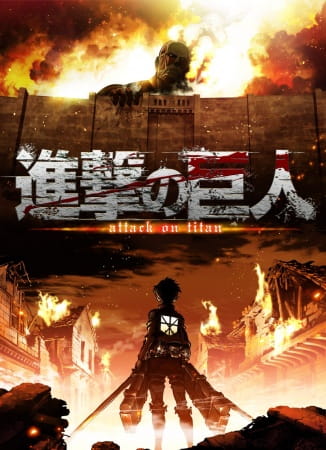
Background
I am really enjoying the series Attack on Titan. I enjoy not just the fact that it is a very interesting world - low fantasy with a bit of steampunk - but I also love that it is just a very good action series. The source material strikes the right balance of action, suspense, and “oh crap” moments. Cliffhanger after cliffhanger month after month. Sometimes the tricks are cheap. Sometimes they are brilliant. The author does a good job of just doing crazy stuff month after month after month. I have heard that he has planned out the entire story before even sitting down to start a single panel of the manga. Such planning, if true, is evident in the huge amount of foreshadowing in early volumes that, when you go back to read them again, are now oh so obvious once the scales have fallen from your eyes.
The anime follows the manga’s plot closely and in general does not try to mess up a good thing. The main problem is that there are only 48 chapters in the manga out right now (one a month, and it has been going for about 4 years now). Because of the artist’s rather slow pace (due to his drawing style and its action packed tone), the anime has to deal with the fact that if it were not careful then it could go really too fast and overtake the manga, creating a Game of Thrones like problem that will be unpleasant.
In the early episodes, it seems like the studio is having trouble getting its feet under itself. There are copious amounts of still images and frames where it seems like they are rushing to get this done in time and falling behind in animating the entire show. Or perhaps they just did not have a budget. The studio was a spin off from a much larger, more established production studio and they were probably also dealing with logistics issues from the very beginning. Not only that, the head producer has said that he was not sure that this would be a hit. In an interview he said: “To be honest, in Japan, the most popular anime are the ones with moe characters, a lot of girls in it, and no cruel scenes. I thought these were the shows that would make it big, so initially I thought Attack On Titan would be a minor hit at best.”
The show turned out to be a whole lot more than that and it has caught on very quickly. Presumably, an increased budget and more stable footing has come along with this unexpected popularity. The result has been quite clear in how dramatically the production values have improved in the second half of the season, the female titan arc. The story is one of the gut wrenching arcs in the entire print series (there are admittedly only 4). Now animated, it has probably the best action scenes that I have seen in a series since Full Metal Alchemist Brotherhood. In this post, I want to break down one sequence in particular from episode 18, the chasedown of the protagonist Eren and his group of fellow squad members by the eponymous female titan.
This scene begins at roughly 19 min 53 seconds into the 24 minute episode.
Setting the Tension
Entering the scene, there is sense of dramatic irony overhanging the show’s characters. What is dramatic irony? It is a narrative device in where the viewer is given a piece of information that at least one of the characters in the narrative is unaware of. The female titan has already made its appearance to the viewer in episode 17 and it has already been shown earlier in episode 18 destroying a number of the scout group. Furthermore, it was discerned and revealed to the viewer that the titan is seeking the protagonist Eren for reasons unknown. The viewer is aware of this but Eren is not.
Building further and adding yet more to the tension, Eren and the group of titan-hunters he has been grouped with do not know just how dangerous this particular female titan is. That it has so far killed over a dozen of their comrades with relative ease. The only indication to them that there is something wrong are the constant sending up of black smoke flares that do little to actually convey the sheer danger they are in.
Tense enough yet? Well, beyond what the viewer already does know is what he doesn’t, layering on a classic atmosphere of Hitchcockian suspense.

Earlier in the episode, the commander approaches a dense forest of old growth trees and passes orders down to his entire troupe to split up. Eren’s group would travel through the forest while the rest of the team is told to stay in the trees and keep watch over the perimeter. This does not seem to make sense. Eren looks around and is shocked to find that the rest of his group mates, who he looks up to and respect as very experienced titan-killers, to be just as puzzled and confused over the mysterious set of orders.
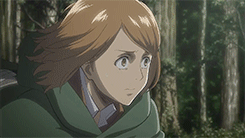
This sets a tension that is permeated throughout the entire scene to follow, that of uncertainty. The commander has passed down orders that at the surface seem incomprehensible and certain to lead to death. It is within this uncertainty that they are expected to finally face down the thing that has been killing their groupmates.
The last thing that we as viewers do not know is the female titan’s actual location. It is not shown entering the forest. Thus the viewer is kept in suspense about how close it really is to Eren and his group. Up until the scene begins we do not know its location. Only another black smoke flare, accompanied with a pounding ominous music, gives a rough approximation of its location. It could very well be meters away from Eren himself. Wisely, a la the shark from Jaws, the director keeps the titan’s placement veiled until the absolute last moment for the big reveal.
The Bomb Under the Table Ticks
The scene begins with the hiss of black smoke. Like the floating yellow shark barrels in Jaws, they are a sudden signal that the peace is over and things are about to happen. It is a declaration. We immediately hit the ground running. Eren and his five comrades are riding horses through the forest, led by their corporal Levi. Levi leads the way, not looking back. He gets himself battle ready (by pulling out a pair of swords) and warns the rest of the troupe that when the threat arrives it will be seen for a very brief second. He is wrong in this assessment, but the viewer (and Eren too) does not know that. Thus the viewer is set in a tone of mood that his eyes are darting across the entire screen. He watches everything. Looks for everything. Anything that might be a threat. It puts us on high alert, draining our energy and coiling our stomachs.
The music plays its part as well. A strong rhythmic beat begins, accelerating. It meshes with the patter of the horses’ hooves, adding its own part to the rhythm. We are not sure what is going on. We cannot see it, but we can hear it. The music is at just the right rhythmic speed that it puts us on edge. It is faster than our own heart beat and subconsciously our brain adjusts our heart beat to match it. This physical action has a strong emotional impact and the suspense starts to get to us in a real bad way.
Suddenly we see a lone soldier break into view from a patch of trees. He is not looking at the screen, facing away towards another direction. It instinctively makes us look away too. We want to see what we cannot. This is the same situation as that of Eren. Eren cannot see what this single soldier is seeing. We want to see what it is. How close is it? When will it finally appear?
The music dulls and slows down, mimicking those momentous events in our lives when we suddenly remember everything in a single second. In reality, our brains are not really recording everything in slow motion. It is in fact a post-event effect of our memory. Our brains have marked this particular event as truly important so it makes a point to enter every second of it into memory. And when we play it back in our minds, we see so much more detail. The result is like taking high speed footage of an event and playing it at a regular 60 frames per second. It is slow. Filmmakers try to emulate this technique to try to stimulate a similar response. We need to take in everything. We need to pay attention.
Then suddenly the female titan makes her appearance in a fast, real fast burst. The camera jolts and jerks (note this for future reference) and the perspective suddenly twists about. We are not sure what is happening and disorientation sets in. We are confused and in that instant of confusion, the titan appears from behind a tree and smacks down the unnamed soldier like so much a fly. The music announces her presence with a loud explosive BANG.
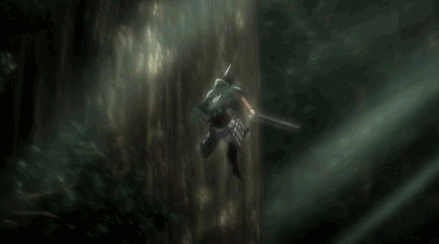
The Titan Appears
Things suddenly move very fast from here. Levi shouts out the order to “Run!” and the music picks up the pace. The viewer feels tense and on-edge from a suspenseful scene because they are aware of their own lack of knowledge about the development of something meaningful on the screen. The source of the suspense has changed. The focus is no longer on where the titan is, but instead on the chase. The female titan is now present on the screen so that tension has been relieved. However, several other elements are added.
The titan has appeared and Eren’s group mates quickly fill in some necessary exposition in order to inform Eren and the viewer of the gravity of their situation. The Titan is fast. Though it starts quickly behind them, it is faster than their horses can cover. It quickly gains on them. Camera-wise, the animators help ground this feeling with one particular scene that establishes the relation of distance between the female titan and Eren. After quickly killing the soldier, the camera cuts to several closeups of the characters, but then switches to one extended action sequence where the camera pans away from the group quickly to the left to show the titan running at pace with them at a distance away. The titan then abruptly changes direction to approach the fleeing group from the right side. She leaps through a tree in the way smashing it into wooden bits and there is a quick instant where she hovers over Eren in slow motion. She reaches for him but misses and falls behind them. However she quickly recovers and rejoins the chase.
It is a great sequence with many of the slow-mo elements we have seen earlier. However it is included for more than to just show off the animators’ talents. This particular sequence definitively establishes their relational positions in space between the relevant characters in the scene: The female titan and Eren’s group. If you notice, because of the sheer scale of the players, we do not have context references for who is what and is where. This “pan back” distance type shot lets the viewer know immediately that the titan is right on their tail and is not very far back. We know that this is no gimmick of the camera (in other words, no cheap cuts). The titan is right there.
This establishment of relational positioning is important in keeping the viewer from getting confused about who is where. Without scenes and references like this, someone can get too bogged down in the question of “What is going on?” and be distracted from the feeling of “Oh no, what is going to happen now!” In addition, knowing exactly where the titan is in relation to where Eren is lets the viewer extrapolate in their own heads about just how much time they have left before they are overrun. The more extrapolation intentionally left to the viewer, the more suspenseful and tense the scene turns out to be.
And do not forget that there is still one major tension lingering in the background of the viewer’s mind: The viewer remains unaware of whether or not the appearance of the titan has been planned for. In other words, whether the commander - who, if you remember, passed down specific orders to split up the troupe and send only Eren’s group alone down the forest path despite the apprehensions of Eren and even many of his more experienced soldier peers. Their tension is shared by the viewers as well.
Grab, Pull, and Die
Now the scene is established. We know exactly where Eren and his pursuer is. We know what we are to be uncertain of and why. It is time to escalate the stakes. Three soldiers appear from behind the female titan, offering reinforcements.
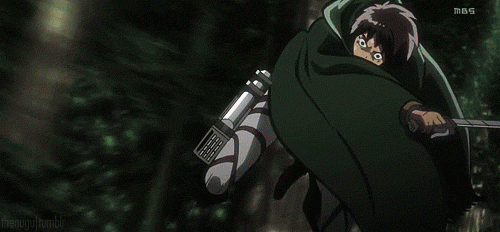
Looking at both the clips above and below, we note a few things.
First, we get flash second glimpses of the soldiers’ faces before they killed in a bloody burst of a cloud. This is a deliberate choice by the animators. You would think at first, “Wait a second, why bother to spend time to give tangible facial expressions to something you would see for less than a split second?” These take time, money and investment to design, draw, and animate. It is not just an attention to detail. It is about taking advantage of our ability to subconsciously process imagery very quickly. We see their faces even though we do not “see” them. Not seeing them would take us out of the scene and we would break the emotional impact.
Second, notice that the entire scene (despite the gifs breaking it up into two) is just one cut. This is also deliberate because it then gets to show off the camera’s jolting movements. What path is it following? Let us track it.
-
The soldier fires off a pylon and the camera tracks its movement, quickly it propels itself backwards away from the soldier at a fast speed.
-
It bursts through the female titan’s hair, just barely missing it and the camera seems to follow the pylon right through the spread of her hair
-
The camera would continue along but suddenly the female titan grabs the wire attached to the pylon and arrests its movement
-
She pulls and the camera stays fixed and suddenly the helpless soldier is brought into the briefest of focuses very very quickly before being crushed against the tree in a cloud of blood
The camera slows its movement to give extra emphasis, slowing down the sequence events so that viewer can absorb the details. However, the camera does not linger too long. Now comes the immediate next scene.
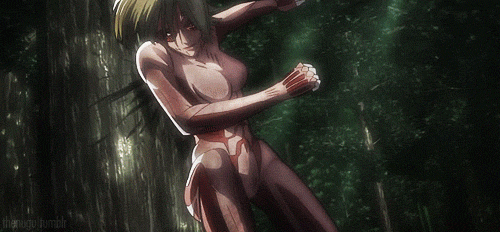
-
The female titan spins on her heels (in a nice bit of flair from the animators). The camera pulls back far far away from her. It is almost like as if the camera, echoing our own thoughts, wants to get as far away from her as possible. We want to escape too.
-
The second soldier swings into view and gets close to the camera and we see his face and it seems like as if he might get away
-
The camera stops its backwards movement and suddenly we are being pulled back towards the female as she grabs the soldier’s pylon-wire and drags it back towards herself
-
The soldier is crushed between the female titan’s fingers and the scene ends with her eyes filling the entire screen gazing out towards the viewer
So in this quick sequence the camera bursts backwards, stops abruptly, then pulls backwards again faster before quickly reversing and exploding forwards. This short sequence seeks to emphasize the female titan’s agility, intelligence, and brute strength. The movements she executes the viewer experiences through the camera’s jolts and they reverse quickly and always convey a sense of great movement.
The Cliffhanger
The speed and quickness with which the reinforcements were dispatched does the job it is meant to do. It is shocking. But to add to the impact, the immediate next cut shows Petra, one of Eren’s team members, looking back off screen at what we presume to be the scene we just saw, turning her head forwards to Corporal Levi and asking in a cracking voice for orders. This reaction shot - a shot that shows not the actual event but observers’ reactions to it - is a powerful mood setter. Recall Darth Vader’s first scene in the movie the Empire Strikes Back. He slowly walks towards a group of Imperial Officers and the camera focuses not on him but instead on the facial expressions of everyone else around him … watching him. By watching not the subject but rather the reactions of other people in the scene we are subconsciously influenced to mirror those feelings. In the case of Petra and Eren, the moods we are influenced to mirror are simple: abrupt shock and sheer fear.
The scene ends with a cliffhanger, but the rampup to it is handled expertly. Near the end of the scene, they flash to a high perspective, looking down on the group as they flee the approaching titan and the way that the camera is set up the approaching titan is mere meters away from them, creeping up from the bottom right of the screen.
The rest of the group call out to Levi, who up until now has not said a single thing. While the rest of Eren’s groupmates nearly break out in panic, the leader has remained silent. He is a naturally silent and stoic character. Does he know what to do? Is this all part of the plan? It is not for certain, and when Levi finally reacts and does something, the scene abruptly ends with cut to black.
Action scenes are tough to coordinate and direct. This is because action in the real world is not nicely coordinated. It is marked with craziness and chaos. The movie director’s job is to bring order to that chaos with good camerawork and expert but sparse dialogue. This simple scene in Attack on Titan has a simple premise: The female titan is chasing Eren and closing quick. However, the nuances underneath its execution demonstrate something really impressive.
Share